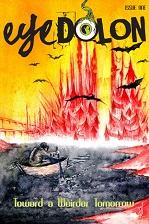 Eyedolon #1, November/December 2017
Eyedolon #1, November/December 2017
“Y” by Maura McHugh
Reviewed by Kat Day
Eyedolon is a new bi-monthly, professionally-paying (8c/wd.) ezine published by Broken Eye Books and funded via Patreon. It comes with the strapline ‘toward a weirder tomorrow,’ and, as this might suggest, it features weird fiction. In his introduction, Scott Gable says, “there is no overarching theme to the stories in Eyedolon more specific than simply ‘weird.’” He goes on to add: “The weird sits […] between the ‘impossibility’ of fantasy and the ‘certitude’ of science fiction.” An interesting place to explore, to be sure!
Appearance-wise this magazine has a minimal look. The front cover features a gloriously disturbing watercolor by Nick Gucker, but the interior is almost entirely plain text, with only two black and white drawings of what is, I assume, Dolon from Greek mythology.
There are two complete short stories in this issue which are covered in this review. The first parts of two serials – “The Obsecration” and “The Night Museum” – also form part of this issue. These are not reviewed here except to say that I found part one of “The Obsecration,” which is titled “Who Beareth the Body,” to be the more engaging of the two. It’s a compelling horror piece which really captures the disorientation one feels during a nightmare.
The first of the short stories is “Y” by Maura McHugh and is described in the magazine’s introduction as a “very personal apocalypse.” In it we meet young Ygraine who is struggling with the fact that the world does not seem quite right to her. As she grows up certain things seem to click into place, including her name which becomes shortened to the titular Y, pronounced ee. Eventually she ends up on a bus which makes a short stop at a town called Kilcailligh, and Y wanders into the town to meet her fate. The character of Y was compelling and I found myself wanting to understand what was happening to her. Both the description and the world-building are excellent, and the story leaves us with a thought-provoking question about accepting one’s true nature. Or not. Although I enjoyed this piece the ending left me with an “oh, is that it?” feeling. Upon second reading, I believe it does make sense to end the story at that point, but I can’t escape the fact that first time through I found it an unpleasant jolt.
“Patio Wing Monsters,” by S. P. Miskowski, is a story about convalescence. Gillian is staying in part of a psychiatric institution which has been set aside for teenagers. Her temporary home is the “Patio Wing” of the title, and we’re told its layout is meant to imitate home life—very different from the scarier sounding “Cactus Wing” whose adult inmates are not allowed to mix with the others. Gillian has injuries on her arms which are suggestive of self-mutilation or a suicide attempt, although their exact cause is never revealed. She is regularly made to attend therapy sessions which she doesn’t find particularly useful. This is an odd piece—fitting for a magazine featuring weird fiction—which hints at a ghost story but never develops into full horror. In some ways I appreciated this: the haunted insane asylum trope has been done… well, to death. This piece instead emphasizes the mundane, every-day horror of such a place. It’s a powerful piece in some respects, but again I found the ending problematic. Several compelling characters are introduced and none of their stories felt complete by the end. Perhaps this reflects reality—a stay in a psychiatric institution does not solve every problem and tie up every loose end—but it doesn’t make for the most satisfying story.
Kat Day writes the award-winning, non-fiction science blog The Chronicle Flask. She has had a short story published in Daily Science Fiction and has another upcoming in “24 Stories,” an anthology to raise money for the survivors of the Grenfell Tower tragedy. Follow her on Twitter @chronicleflask.